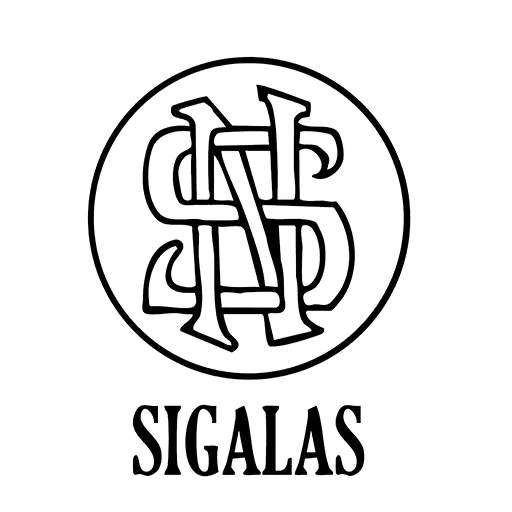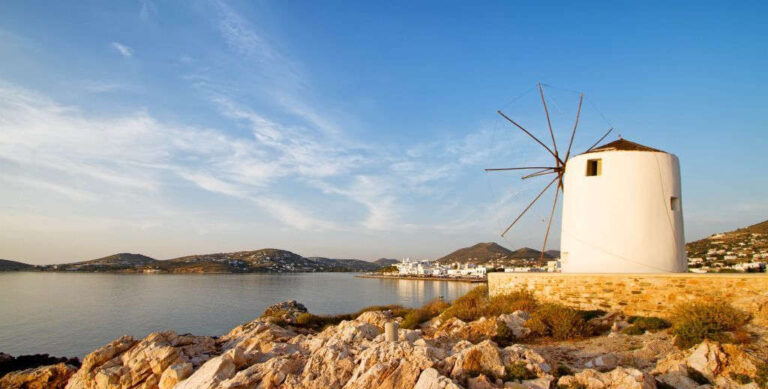History of Paros
Paros has been inhabited since 3200 BC, according to the excavations that took place on the islet of Saliagos, located between Paros and Antiparos. According to mythology, the Cretan Alkaios was the first king of Paros and built a city on the site of the present capital of Parikia. During those times, Crete was trading with Egypt, Assyria, and the Balkans.
Paros was an ideal place due to its strategic position (in the center of the Cyclades) and the fertile land. The Cretans transformed the island into a naval station and gave it the name of Minoa, an honorific title given to Royal Cretan cities. In 1100 BC, the Ionians came to take the island and, after a first defeat, they managed to win the Minoans, destroyed their civilization and became rulers of the island.
Traces of the former civilization can be seen in the Mycenaen Acropolis near Kolimbithres. In 1000 BC, Paros was taken by the Arcadians. The 8th century BC was a prosperous period for the history of Paros, as the island become a maritime power and created a colony on the island of Thassos, rich in metal deposits. Apart from the economic development, there was cultural flourishing including the construction of many temples, like a temple dedicated to goddess Athena and the healing center of Asklepieion.
Paros is the birthplace of many ancient poets such as the lyrical poet Archilochus who was the first to use in his poems personal elements rather than heroic ones.
During ancient times, Paros was famous, around the Mediterranean, for its high-quality semi-transparent marble, found at the Marathi Quarries. The same used to build many works of art and masterpieces such as the Temple of Apollo on Delos, the Venus of Milos, the statue of Hermes (Praxiteles) at Olympia and many others.
The story that Paros of Parrhasia colonized the island with Arcadians is an etymological fiction of the type that abounds in Greek legends. Ancient names of the island are said to have been Plateia (or Pactia), Demetrias, Strongyle (meaning round, due to the round shape of the island), Hyria, Hyleessa, Minoa and Cabarnis.
The island later received from Athens a colony of Ionians under whom it attained a high degree of prosperity. It sent out colonies to Thasos and Parium on the Hellespont. In the former colony, which was planned in the 15th or 18th Olympiad, the poet Archilochus, a native of Paros, is said to have taken part. As late as 385 BC the Parians, in conjunction with Dionysius of Syracuse, founded a colony on the Illyrian island of Pharos.
Shortly before the Persian War, Paros seems to have been a dependency of Naxos.[In the first Greco-Persian War (490 BC), Paros sided with the Persians and sent a trireme to Marathon to support them. In retaliation, the capital was besieged by an Athenian fleet under Miltiades, who demanded a fine of 100 talents. But the town offered a vigorous resistance, and the Athenians were obliged to sail away after a siege of 26 days, during which they had wasted the island. It was at a temple of Demeter Thesmophoros in Paros that Miltiades received the wound from which he died. By means of an inscription, Ross was able to identify the site of the temple; it lies, as Herodotus suggests, on a low hill beyond the boundary of the town. Church of Zoodohos Pigi, Parikia
Paros also sided with Shahanshah Xerxes I of Persia against Greece in the second Greco-Persian War (480–479 BC), but, after the battle of Artemisium, the Parian contingent remained inactive at Kythnos as they watched the progression of events. For their support of the Persians, the islanders were later punished by the Athenian war leader Themistocles, who exacted a heavy fine.
Under the Delian League, the Athenian-dominated naval confederacy (477–404 BC), Paros paid the highest tribute of the island members: 30 talents annually, according to the estimate of Olympiodorus (429 BC). This implies that Paros was one of the wealthiest islands in the Aegean. Little is known about the constitution of Paros, but inscriptions seem to show that it was modeled on the Athenian democracy, with a boule (senate) at the head of affairs. In 410 BC, Athenian general Theramenes discovered that Paros was governed by an oligarchy; he deposed the oligarchy and restored the democracy. Paros was included in the second Athenian confederacy (the Second Athenian League 378–355 BC). In c. 357 BC, along with Chios, it severed its connection with Athens.
From the inscription of Adule, it is understood that the Cyclades, which are presumed to include Paros, were subjected to the Ptolemies, the Hellenistic dynasty (305–30 BC) that ruled Egypt. Paros then became part of the Roman Empire and later of the Byzantine Empire, its Greek-speaking successor state.
In 1204, the soldiers of the Fourth Crusade seized Constantinople and overthrew the Byzantine Empire. Although a residual Byzantine state known as the Empire of Nicaea survived the Crusader onslaught and eventually recovered Constantinople (1261), many of the original Byzantine territories, including Paros, were lost permanently to the crusading powers. Paros became subject to the Duchy of the Archipelago, a fiefdom made up of various Aegean islands ruled by a Venetian duke as nominal vassal of a succession of crusader states. In practice, however, the duchy was always a client state of the Republic of Venice.
Ottoman Era and independence
In 1537, Paros was conquered by the Ottoman Turks and remained under the Ottoman Empire until the Greek War of Independence (1821–1829). During the Russo-Turkish War (1768–1774) in 1770–1775 Naoussa Bay was the home base for the Russian Archipelago Squadron of Count Alexey Orlov. Under the Treaty of Constantinople (1832), Paros became part of the newly independent Kingdom of Greece, the first time the Parians had been ruled by fellow Greeks for over six centuries. At this time, Paros became the home of a heroine of the nationalist movement, Manto Mavrogenous, who had both financed and fought in the war for independence. Her house, near Ekatontapiliani church, is today a historical monument.
Source: Wikipedia




